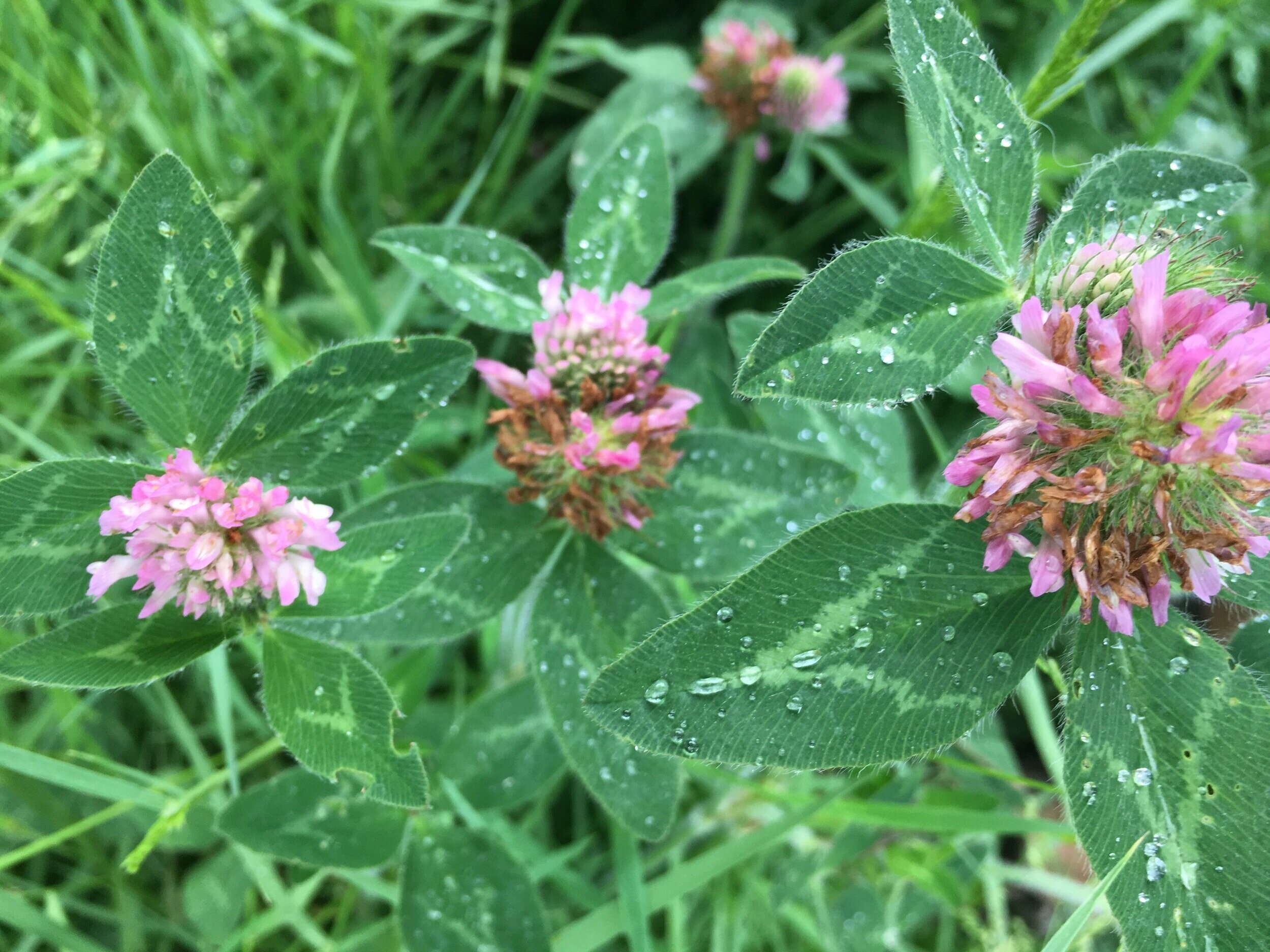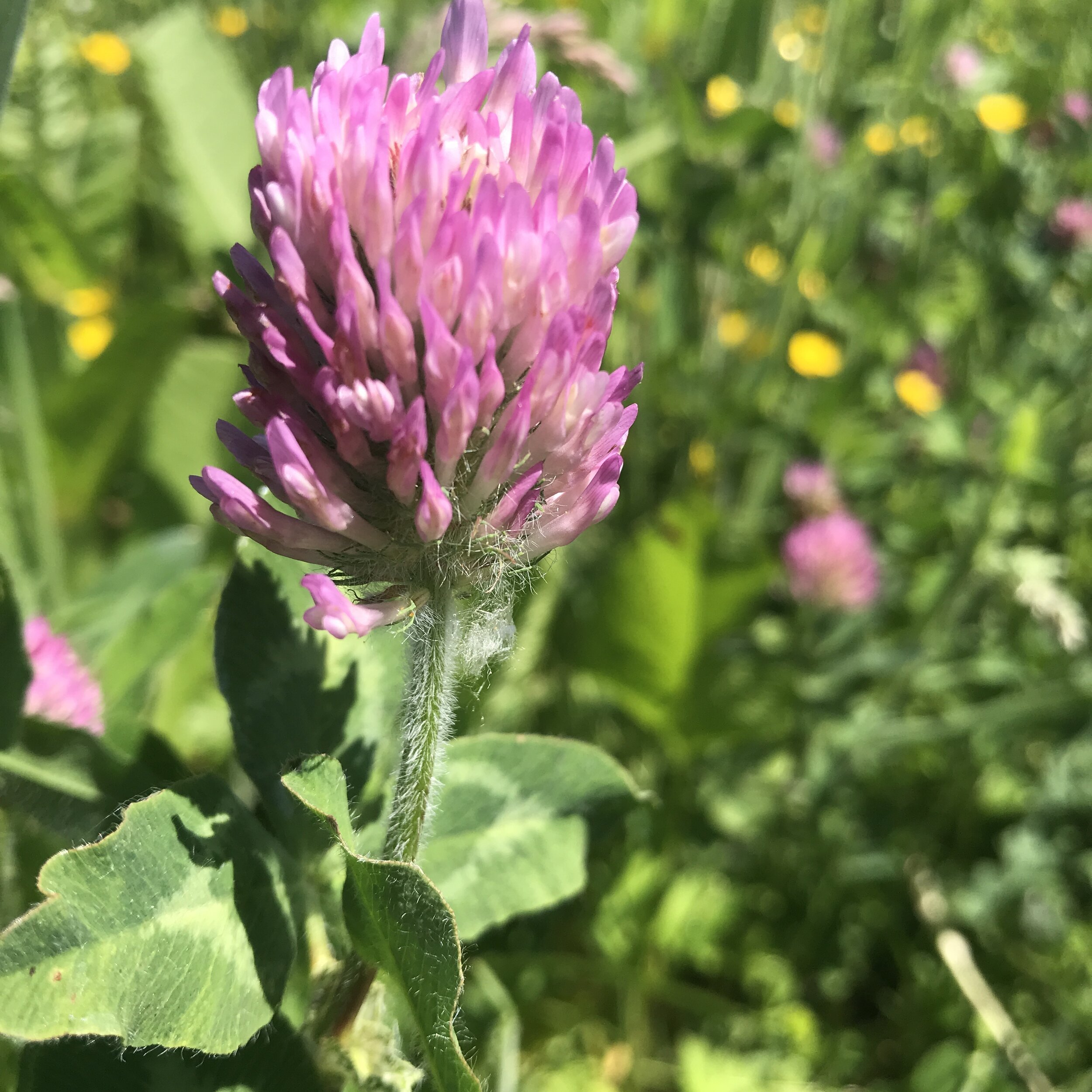Botanical Name: Trifolium pratense
Plant Family: Fabaceae, Pea Family
Parts Used: Top Flowering parts (Flowers and upper leaves)
Actions: Alterative, Antispasmodic, Lymphatic, Nutritive
Energetics: Cooling
Tastes: Bitter, slightly Sweet
Habitat: Red clover is a nitrogen fixer. Some may call it a “weed”. It is commonly grown as a cover crop in farm fields or gardens, yet is also found in its own natural element. This herbaceous plant escaped from Eurasia and can grow to be a 6-24 inch biennial or short-lived perennial. Red clover will grow in heavy clay soils or even sandy-loamy substrate. Since it provides nutrients for the soil, it can grow in an array of conditions- including disturbed surfaces, roadsides, grassy fields and meadows. Red clover likes full to part sun.
Identification: Red clover’s latin name “Trifolium” denotes three (tri) leaflets of each compound leaf (folium). This is common amongst many clovers of this genus, yet red clover differentiates itself with a whitish chevron symbol near the base of each leaflet. The leaflets are lance-to egg-shaped and grow to be no larger than 1 1/2 inches. Each leaflet has soft hairs as it grows in an alternating arrangement along the stem. Red clover has an almost fuchsia like color to its flowers. The flowering head forms a conical to globe-shaped top with anywhere between 40-200 flowers. Once you look closely at each individual flower, you can see the Fabaceae flower structure with the “banner, wings and keel.” The flowers emerge from late Spring into late Summer.
This is a picture of a red clover flower that is beginning to “compost” -die back. It is past its prime to be harvested, yet it can be used for seed if it doesn’t mold.
Collection: Red clover is harvested once the flowers fully bloom. It’s a tricky plant to catch in its prime due to the succession of its bloom. Ideally, one would harvest the flowers before they are pollinated and “composting” away.
Pick the flowering tops (including the upper leaves that grow directly beneath the flower head). To ensure future harvests, follow the 1:10 rule of harvest- leave some flowers for insects and other pollinators as well as seeds for next year’s crop production!
Preparation Tips: Red Clover makes a beautiful tea. However, it can be difficult to dry the flowers and preserve their color and potency. The flowers hold a lot of moisture and can easily mold. When drying, make sure you have good airflow in a dry environment. Flip or turn flowers over occasionally throughout drying process.
RED CLOVER FOOD:
Red clover is high in nutrients. It is mineral-rich, moistening, nourishing and high in amino acids.
Red clover contains potassium, iron, magnesium, manganese, calcium and diadzen. It’s rich phytonutrients, vitamins and minerals not only support healthy soils, yet also provide healthy gut flora.
One of my favorite ways to absorb the nutrient dense qualities of red clover is to drink it as an herbal infusion. The bitter sweet tastes come to fruition and fuel the body.
White clover instead of red clover?
I have only used white clover as a food alternative (or addition!) to red clover. It doesn’t seem as if white clover has the same medicinal qualities as red clover. However, it makes for a delicious tea and a yummy edible flower. Check out the following pages for recipe inspiration:
White clover iced tea
white clover pudding
INFUSE RED CLOVER IN TEA INFUSIONS, HONEYS, VINEGARS, TINCTURES AND HERBAL GOURMET; SALADS, MUFFINS, RICE, JUICES AND SYRUPS!
RED CLOVER MEDICINE:
Female Menopausal ally and beyond
Red clover is a superior herbal ally for women experiencing hormonal changes during menopause. Specifically, the herb is cooling and helps reduce hot flashes. Studies have shown that extracts of Trifolium pratense (80 mg) can help treat menopausal hot flashes- that is to say an extract and not the plant in its entirety was studied.
According to Scott Kloos’s book, “Pacific Northwest Medicinal Plants,” red clover is a harmonizer for hormonal imbalances, irregular menstrual cycles, chronically painful menstruation and also improving fertility.
Skin health
Red clover is an amazing herb for the skin. Specifically skin conditions such as eczema, psoriasis, acne, lymphatic swellings, chronic inflammations and infections, and skin ulcers. According to Traditional Chinese Medicine, red clover clears heat, resolves fire toxicity, quickens blood and reduces swelling. It can help with both internal and external conditions. Conditions such as eczema and psoriasis indicate “toxic heat” or “heat in the Blood”- hence, cooling herbs are affective.
In Western herbalism, red clover is referred to as an “Alterative.” Meaning, it is an herb that helps with lymphatic movement which ultimately removes toxins from the Blood. In this case, toxins create heat and also skin rashes or outbreaks as a result. Toxins can also accumulate, hence the Blood stagnation can also cause skin flare ups in addition to swelling and inflammation.
Red clover helps eliminate metabolic wastes from our body through the Blood and lymphatic systems. This herb can be used in combination with sarsaparilla and sassafras for various skin diseases. It is also commonly combined with dandelion, chickweed, calendula and burdock to further cleanse the skin and lymphatic system.
ANTI-spasmodic
Red clover can be combined with grindelia, marshmallow root, licorice or plantain to help moisten and combat dry, spasmodic coughs. Red clover is said to be mildly anti-spasmodic, traditionally used for the whooping cough. Due to its “mild” affects, I tend to use Wild Cherry bark or other stronger anti-spasmodics instead of red clover.
Cautions
Red clover contains blood-thinning coumarins- it is not advised to use this herb if you are taking any sort of blood-thinning medication. Also, do not take red clover in large quantities prior to any surgery.
Some concern has been shown in regards to red clover contributing to estrogen-receptor positive cancer. No studies have been conducted in regards to this information- so, red clover should be avoided in any cases (past or present) of estrogen-receptor positive cancer.
There is no information claiming red clover as a “safe” herb for pregnancy or lactation.
RECIPES:
Red clover sprouts
INGREDIENTS:
Red Clover Seeds
Water
Quart Jar
Cheesecloth
Rubber band
DIRECTIONS:
Measure 1 tablespoon of seeds into a quart jar, cover with water and swirl to completely moisten all the seeds.
Cover the mouth with the cheesecloth, fastening it on with a rubber band.
Let sit for about 10 minutes.
Strain off the water and lay it sideways on the countertop.
Rinse twice a day.
You should start seeing sprouts in a few days. When sprouts are about 1” long they are ready to eat.
These tasty sprouts are a great addition to salads and sandwiches or as a soup topping. Sprouts are a great way to get some extra nutrition into your meal!
Recipe by Kristine Brown with Herbal Roots Zine
Red Clover Mead
Ingredients:
3 quarts red clover heads
1 gal of water
2 pounds honey
2 lemons
1 packet champagne yeast
DIRECTIONS:
Pour the boiling water over the clover bloom, in a kettle, bring to the boil, and simmer gently for half an hour.
Strain this infusion onto the honey, thin sliced lemons and tea.
Cool to lukewarm and add yeast.
Let it work in the fermentation jar for three months, by which time it will be a clear lovely pink, and ready to bottle.
Red Clover rice salad
Ingredients:
2 cups rice
3 Tbsp olive oil
6 Tbsp lemon juice
1½ tsp salt
6 scallions, minced
1 cup Hickory or Black Walnuts (use any nuts if you don’t have these)
1 cup chopped dried fruit (try raisins, goji berries, dates, or apricots)
2 cups Red Clover flowers, plucked out of the flowerheads'
DIRECTIONS:
Cook rice in 6 cups of water until done.
Do not stir while cooking or cooling. Let cool completely before mixing salad to avoid rice becoming sticky or gummy.
Add all the above ingredients and mix thoroughly.
Chill and serve, or serve at room temperature.
Recipe by Rose Barlow
Resources
Red Clover; Featured Herb by Rosalee de la Forêt in Herbmentor.com
Western Herbs According to Traditional Chinese Medicine by Thomas Avery Garran
The New Holistic Herbal by David Hoffman
Pacific Northwest Medicinal Plants by Scott Kloos
Planetary Herbology by Michael Tierra




